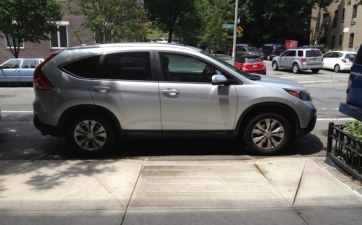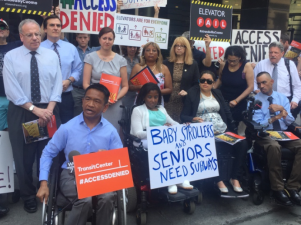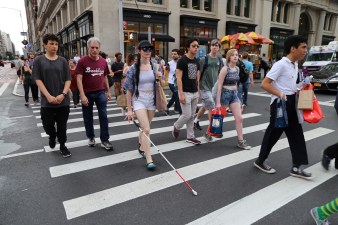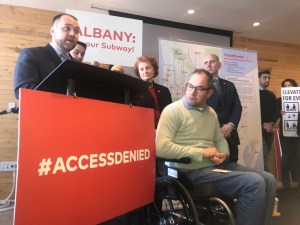Feds: City’s Interpretation of Disabilities Act is ‘Wrong’
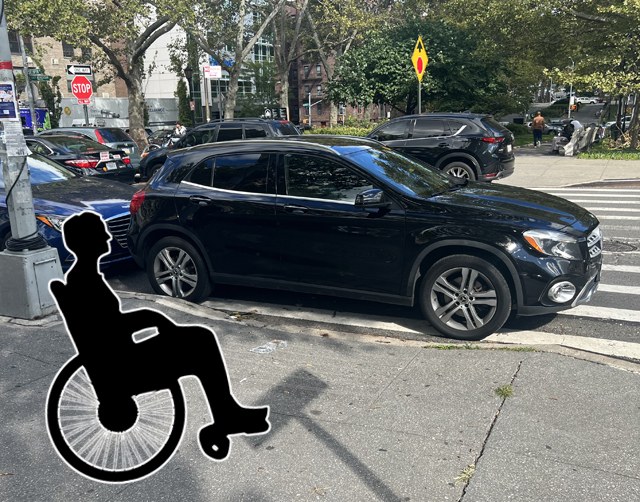
The federal government says the city’s interpretation of the Americans With Disabilities law is wrong, and that the city must clear pedestrian pathways and remove any interferences to the disabled — and that includes placard abusers or illegal parkers.
The Oct. 5 brief was submitted by the Department of Justice in a lawsuit brought in June by the advocacy group Disability Rights New York on behalf of residents of the Mount Eden neighborhood of the Bronx and two disabled residents who say they can’t navigate their neighborhood because of illegally parked cars.
“The ADA requires not only that the city create pedestrian pathways that are accessible, but also that the city maintain the accessibility of those pathways, including by removing barriers to accessibility put in place by third parties,” the Justice Department said this week in court papers filed on behalf of the plaintiffs.
Those injured parties include Carlos Diaz, who has cerebral palsy and needs a wheelchair to move around, and his wife, Stephanie Diaz, 32, who suffers from keratoconus, a degenerative eye disease that has resulted in loss of vision.
The case is one of many that frequently charge the city with failing to uphold the ADA, the landmark 1990 federal legislation that required all public entities to operate their programs, services and activities in a way that is accessible to people with disabilities. But this one has a twist connected to both the pandemic and the city’s unique problem with placard abuse.

Illegal parking got worse during the pandemic in the Mount Eden Malls area after the city issued special Covid-19 placards for healthcare workers, according to the suit. Those permits have now expired, but the Diazes’ suit argued that the permits weren’t the problem; the problem was people illegally parking and blocking pedestrian pathways without any enforcement.
Since 2020, Stephanie Diaz has been tracking illegal parking/permit violations in her neighborhood, and in the mere three-month period between Jan 1. and March 31, 2021 recorded 45 cases of illegal parking in front of curbs, according to the suit.
Earlier, she had submitted 25 311 service requests that were closed within an hour of being opened. The NYPD said the issues were “resolved,” but Diaz says in her suit that they were not, which is consistent with findings made by Streetsblog last year when it examined the NYPD’s poor response to thousands of 311 complaints on driver misconduct.
Nonetheless, the city argued that the Diazes’ suit should be dismissed, arguing, essentially, that the Diazes’ freedom of movement was subservient to a larger public safety goal of the NYPD.
“As the Mount Eden section of the Bronx has a history of high crime, it is entirely appropriate for the NYPD to determine how to best allocate its scarce resources in this area in response to recent surges in dangerous crime,” the city argued in court papers. “Unfortunately, the NYPD does not have limitless resources to devote to issuing parking summonses and towing illegally parked vehicles in this Bronx neighborhood when there are shootings, stabbings, robberies, and other crimes in the area outside of the hospital.”
The director of Disability Rights New York slammed that legal jargon as deeply offensive to people with disabilities.
“The city of New York should be leading by example. Instead, they are intentionally shirking their responsibility to keep pedestrian pathways accessible and safe for everyone,” DRNY Executive Director Timothy Clune said in a statement. “Consistent with their decision to allow these barriers to exist in the first place, the city is clearly not taking the path of least resistance in this case.”
Carlos Diaz has a deeply personal connection to the suit. In December 2019, he was crossing the street in his wheelchair when he was hit by a driver who failed to stop at a stop sign.
“I am frightened that I will again get hit by a moving vehicle … and sustain injuries that will prevent me from working, being a father and partner, or kill me” he said in his court declaration.
The city’s failure to carry out its requirements under the ADA is a constant struggle for disabled New Yorkers, though there have been repeated efforts to hold the city accountable.
Under former Mayor Bill de Blasio, the city passed a law requiring the NYPD to evaluate at least 25 known placard-abuse hotspots per week for six months. The agency’s findings were to be reported to the Council Oversight and Investigation Committee, but the report was never filed.
In 2021, in response to Streetsblog’s 311 investigation, the oversight committee investigated the NYPDs response to 311 illegal parking complaints, filing 50 parking violation complaints to judge the NYPD response. It wasn’t very good:
- 72 percent of the complaints were inadequately resolved.
- 28 percent of complaints got no NYPD response at all.
According to 311 service request data from 2010 to present, there have been more than 817,000 reported illegal parking complaints across the city since Jan 2020, with 20,967 of those about blocked crosswalks. At the time of this report, 20,962 had been closed. It’s impossible to confirm if the cases were actually resolved by the NYPD, but Stephanie Diaz said that in her cases, the complaints were not in fact resolved.
Disability Rights New York v. City of New York adds to a compounding number of cases brought against the city and other government agencies for ADA violations. In June, the MTA settled a class-action lawsuit to improve subway accessibility. In 2019, the city settled two class-action lawsuits to make sidewalk curbs accessible to all around the city. The city is still far behind in fulfilling the decree.
The Diazes case against the city is not the first time that federal prosecutors have questioned the city’s lax effort on ADA rules compliance. In 2018, the Southern District Attorney’s office filed a similar Statement of Interest calling out the city’s misguided interpretation of ADA rules in a case brought by the American Council of the Blind of New York. That case was about the city’s alleged failure to install pedestrian signals that convey traffic and warning information to visually impaired pedestrians. The city settled in July, paying $945,000 to cover attorney fees and associated costs.
The city Law Department did not respond to requests for comments for this story.
